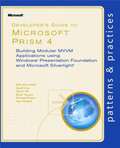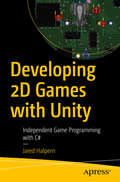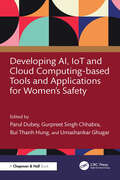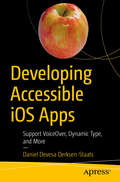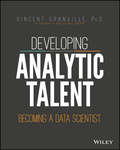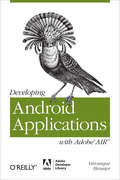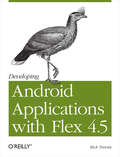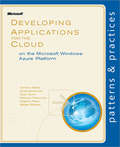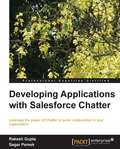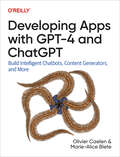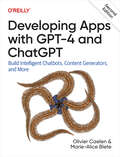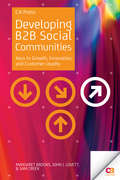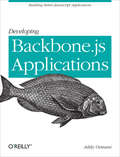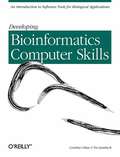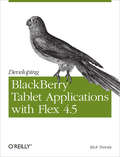- Table View
- List View
Developer’s Guide to Microsoft® Prism 4: Building Modular MVVM Applications with Windows® Presentation Foundation and Microsoft Silverlight®
by Bob Brumfield Geoff Cox David Hill Brian Noyes Michael Puleio Karl ShifflettThis guide provides everything you need to get started with Prism and to use it to create flexible, maintainable Windows® Presentation Foundation (WPF) and Microsoft Silverlight® 4.0 applications. It can be challenging to design and build WPF or Silverlight client applications that are flexible, maintainable, and that can evolve over time based on changing requirements. These kinds of applications require a loosely coupled modular architecture that allows individual parts of the application to be independently developed and tested, allowing the application to be modified or extended later on. Additionally, the architecture should promote testability, code re-use, and flexibility. Prism helps you to design and build flexible and maintainable WPF and Silverlight applications by using design patterns that support important architectural design principles, such as separation of concerns and loose coupling. This guide helps you understand these design patterns and describes how you can use Prism to implement them in your WPF or Silverlight applications. This guide will show you how to use Prism to implement the Model-View-View-Model (MVVM) pattern in your application, and how to use it along with commands and interaction requests to encapsulate application logic and make it testable. It will show you how to split an application into separate functional modules that can communicate through loosely coupled events, and how to integrate those modules into the overall application. It will show you how to dynamically construct a flexible user interface by using regions, and how to implement rich navigation across a modular application. Prism allows you to use these design patterns together or in isolation, depending on your particular application requirements.
Developing 2D Games with Unity: Independent Game Programming with C#
by Jared HalpernFollow a walkthrough of the Unity Engine and learn important 2D-centric lessons in scripting, working with image assets, animations, cameras, collision detection, and state management. In addition to the fundamentals, you'll learn best practices, helpful game-architectural patterns, and how to customize Unity to suit your needs, all in the context of building a working 2D game. While many books focus on 3D game creation with Unity, the easiest market for an independent developer to thrive in is 2D games. 2D games are generally cheaper to produce, more feasible for small teams, and more likely to be completed. If you live and breathe games and want to create them then 2D games are a great place to start. By focusing exclusively on 2D games and Unity’s ever-expanding 2D workflow, this book gives aspiring independent game developers the tools they need to thrive. Various real-world examples of independent games are used to teach fundamental concepts of developing 2D games in Unity, using the very latest tools in Unity’s updated 2D workflow. New all-digital channels for distribution, such as Nintendo eShop, XBox Live Marketplace, the Playstation Store, the App Store, Google Play, itch.io, Steam, and GOG.com have made it easier than ever to discover, buy, and sell games. The golden age of independent gaming is upon us, and there has never been a better time to get creative, roll up your sleeves, and build that game you’ve always dreamed about. Developing 2D Games with Unity can show you the way.What You'll LearnDelve deeply into useful 2D topics, such as sprites, tile slicing, and the brand new Tilemap feature.Build a working 2D RPG-style game as you learn.Construct a flexible and extensible game architecture using Unity-specific tools like Scriptable Objects, Cinemachine, and Prefabs.Take advantage of the streamlined 2D workflow provided by the Unity environment. Deploy games to desktopWho This Book Is For Hobbyists with some knowledge of programming, as well as seasoned programmers interested in learning to make games independent of a major studio.
Developing AI, IoT and Cloud Computing-based Tools and Applications for Women’s Safety
by Bui Thanh Hung Parul Dubey Gurpreet Singh Chhabra Umashankar GhugarIn a world increasingly driven by technology, this book explores the intersection of artificial intelligence (AI), IoT, and Cloud Computing and women's safety, highlighting the transformative potential of technology in safeguarding women's well-being in the physical and the digital world. As the safety and security industry embraces technological advancements, the need for inclusive and gender-centric solutions has become increasingly evident. This reference book delves into this critical area, showcasing the development of AI, IoT, and Cloud applications specifically tailored to address the unique safety challenges faced by women.• Provides a comprehensive exploration of how AI and related technologies are reshaping the future of women's safety.• Emphases the utilisation of AI to tackle the specific challenges women encounter in various contexts.• Introduces innovative solutions such as wearable technology, AI-powered surveillance systems, and mobile applications designed for emergency responses.• Discusses ethical implications of deploying technology for personal security and navigates the evolving legal landscape surrounding data privacy.• Bridges the gap between theoretical discussions and practical implementations, offering a guide to developing technology for the improvement of women's safety.It is an invaluable resource for professionals and researchers interested in the transformative role of AI, IoT, and Cloud in shaping the future of women's safety.
Developing AR Games for iOS and Android
by Dominic Cushnan Hassan El HabbakA practical and fast-paced guide that gives you all the information you need to start developing augmented reality games for iOS and Android.This book is great for people who are either new to Vuforia and/or new to Unity. It is a great introductory guide for anyone with a very basic knowledge of xCode and iOS as well as a very basic knowledge of deploying to Android to start developing 3D-powered augmented reality apps.
Developing Accessible iOS Apps: Support VoiceOver, Dynamic Type, and More
by Daniel Devesa Derksen-StaatsAny developer aiming for a global audience needs to cover a series of requisites for their apps, and one of them is to make them accessible. Just having an app in the App Store is not enough for it to be a global success anymore. More than that, it is arguably our duty as developers to create inclusive apps that anyone can use.Apple provides us with excellent tools for creating accessible apps. However, many developers just don’t know about them or think they’re difficult to us. This concise guide offers a focused look at breaking those myths and proving that creating accessible apps is very easy, and that it’s just as easy to embed accessibility into the development process of your team. You'll have a look at the tools iOS provides. Some, like zoom, button shapes, etc., come integrated in the operating system. Others, like VoiceOver, Larger Accessibility Sizes with Dynamic Types, and Smart Inverted Colours will need extra work to support appropriately. Then go from the basics of giving meaningful accessibility labels to UI components, so VoiceOver can read them, to making your UI support extremely large font sizes so anyone can read our app. And you'll find out how to build accessible apps with real world examples.Accessibility is the right thing to do and will help your app find wider success.What You'll LearnExplore the fundamentals of accessibilityCreate a good VoiceOver experience Incorporate Inverted Colours effectively Test accessibility features for optimization and functionWho This Book Is ForiOS developers wanting to add accessibility features to their apps and any other member in a mobile development team—from Product Managers to Business Analysts or QAs—who would like to incorporate or work with accessibility features.
Developing Analytic Talent
by Vincent GranvilleLearn what it takes to succeed in the the most in-demand tech jobHarvard Business Review calls it the sexiest tech job of the 21st century. Data scientists are in demand, and this unique book shows you exactly what employers want and the skill set that separates the quality data scientist from other talented IT professionals. Data science involves extracting, creating, and processing data to turn it into business value. With over 15 years of big data, predictive modeling, and business analytics experience, author Vincent Granville is no stranger to data science. In this one-of-a-kind guide, he provides insight into the essential data science skills, such as statistics and visualization techniques, and covers everything from analytical recipes and data science tricks to common job interview questions, sample resumes, and source code.The applications are endless and varied: automatically detecting spam and plagiarism, optimizing bid prices in keyword advertising, identifying new molecules to fight cancer, assessing the risk of meteorite impact. Complete with case studies, this book is a must, whether you're looking to become a data scientist or to hire one.Explains the finer points of data science, the required skills, and how to acquire them, including analytical recipes, standard rules, source code, and a dictionary of termsShows what companies are looking for and how the growing importance of big data has increased the demand for data scientistsFeatures job interview questions, sample resumes, salary surveys, and examples of job adsCase studies explore how data science is used on Wall Street, in botnet detection, for online advertising, and in many other business-critical situationsDeveloping Analytic Talent: Becoming a Data Scientist is essential reading for those aspiring to this hot career choice and for employers seeking the best candidates.
Developing Android Applications with Adobe AIR: An ActionScript Developer's Guide to Building Android Applications
by Véronique BrossierPut your ActionScript 3 skills to work building mobile apps. This book shows you how to develop native applications for Android-based smartphones and tablets from the ground up, using Adobe AIR. You learn the entire development process hands-on, from coding specific functions to options for getting your app published.Start by building a sample app with step-by-step instructions, using either Flash Professional or Flash Builder. Then learn how to use ActionScript libraries for typical device features, such as the camera and the accelerometer. This book includes ready-to-run example code and a case study that demonstrates how to bring all of the elements together into a full-scale working app.Create functionality and content that works on multiple Android devicesChoose from several data storage optionsCreate view and navigation components, including a back buttonGet tips for designing user experience with touch and gesturesBuild a location-aware app, or one that makes use of motionExplore ways to use audio, video, and photos in your applicationLearn best practices for asset management and development
Developing Android Applications with Flex 4.5: Building Android Applications with ActionScript
by Rich TretolaReady to put your ActionScript 3 skills to work on mobile apps? This hands-on book walks you through the process of creating an Adobe AIR application from start to finish, using the Flex 4.5 framework. Move quickly from a basic Hello World application to complex interactions with Android APIs, and get complete code examples for working with Android device components—GPS, camera, gallery, accelerometer, multitouch display, and OS interactions. No matter how much Flex experience you have, this book is the ideal resource.Use Flash Builder 4.5 to create and debug a Flex Mobile projectChoose a layout option to determine which files Flash Builder auto-generatesSelect permissions that control which devices can install your app from the Android MarketExplore APIs that enable your app to interact with specific Android OS featuresLearn how to read and write text files, browse the file system for media files, and create and write to an SQLite databaseUse the URLRequest class to open your app in the browser, place calls, and create emails and text messagesLoad web and video content into your app with StageWebViewPublish your app to an Android installer file with Flash Builder
Developing Applications for the Cloud on the Microsoft® Windows Azure™ Platform
by Matias Woloski Eugenio Pace Dominic Betts Scott Densmore Ryan Dunn Masashi NarumotoThis book is the second volume in a planned series about Windows Azure technology platform. Volume 1, Moving Applications to the Cloud on the Windows Azure Platform, provides an introduction to Windows Azure, discusses the cost model and application life cycle management for cloud-based applications, and describes how to migrate an existing ASP.NET application to the cloud. This book demonstrates how you can create from scratch a multi-tenant, Software as a Service (SaaS) application to run in the cloud by using the latest versions of the Windows Azure tools and the latest features of the Windows Azure platform. The book is intended for any architect, developer, or information technology (IT) professional who designs, builds, or operates applications and services that run on or interact with the cloud. Although applications do not need to be based on the Microsoft Windows® operating system to work in Windows Azure, this book is written for people who work with Windows-based systems. You should be familiar with the Microsoft .NET Framework, Microsoft Visual Studio® development system, ASP.NET MVC, and Microsoft Visual C#® development tool.
Developing Applications with Azure Active Directory: Principles of Authentication and Authorization for Architects and Developers
by Manas Mayank Mohit GargExplore tools for integrating resources and applications with Azure Active Directory for authentication and authorization. This book starts with an introduction to Azure Active Directory (AAD) where you will learn the core concepts necessary to understand AAD and authentication in general. You will then move on to learn OpenID Connect and OAuth along with its flows, followed by a deep dive into the integration of web applications for user-based authentication. Next, you go through user authentication and how to enable the integration of various native applications with AAD. This is followed by an overview of authenticating applications along with a detailed discussion on collaboration with external users and other AD tenants. Moving forward, Developing Applications with Azure Active Directory covers using schemas of AD objects, such as users, to add custom attributes on top of ADD’s predefined attributes. You will see how multi-tenancy can be supported in Azure AD as well as how to design authorization with Azure AD.After reading this book, you will be able to integrate, design, and develop authentication and authorization techniques in Azure Active Directory.What You Will LearnIntegrate applications with Azure AD for authenticationExplore various Azure AD authentication scenariosMaster core Azure AD conceptsIntegrate external users and tenants Who is this book for:The book will be useful for architects and developers, planning to use Azure AD for authentication.
Developing Applications with Salesforce Chatter
by Rakesh Gupta Sagar PareekThis book follows a hands-on approach which will help newbies to easily understand the concepts of Salesforce Chatter and its configuration easily. For advanced users, this book has few approaches and code snippets to help you make Salesforce Chatter more responsive and productive. Having fundamental knowledge of Apex and Visualforce pages will be helpful.This book is intended for people who are newbies in the Salesforce arena and who want to boost collaboration in their organization using Chatter. After reading this book, you will be able to configure Chatter all on your own, but for customization tasks such as improving the user interface, you will need a basic understanding of Apex and Visualforce pages.
Developing Apps with GPT-4 and ChatGPT
by Olivier Caelen Marie-Alice BleteThis minibook is a comprehensive guide for Python developers who want to learn how to build applications with large language models. Authors Olivier Caelen and Marie-Alice Blete cover the main features and benefits of GPT-4 and ChatGPT and explain how they work. You'll also get a step-by-step guide for developing applications using the GPT-4 and ChatGPT Python library, including text generation, Q&A, and content summarization tools. Written in clear and concise language, Developing Apps with GPT-4 and ChatGPT includes easy-to-follow examples to help you understand and apply the concepts to your projects. Python code examples are available in a GitHub repository, and the book includes a glossary of key terms. Ready to harness the power of large language models in your applications? This book is a must. You'll learn: The fundamentals and benefits of ChatGPT and GPT-4 and how they workHow to integrate these models into Python-based applications for NLP tasksHow to develop applications using GPT-4 or ChatGPT APIs in Python for text generation, question answering, and content summarization, among other tasksAdvanced GPT topics including prompt engineering, fine-tuning models for specific tasks, plug-ins, LangChain, and more
Developing Apps with GPT-4 and ChatGPT: Build Intelligent Chatbots, Content Generators, and More
by Olivier Caelen Marie-Alice BleteThis book provides an ideal guide for Python developers who want to learn how to build applications with large language models. Authors Olivier Caelen and Marie-Alice Blete cover the main features and benefits of GPT-4 and GPT-3.5 models and explain how they work. You'll also get a step-by-step guide for developing applications using the OpenAI Python library, including text generation, Q&A, and smart assistants.Written in clear and concise language, Developing Apps with GPT-4 and ChatGPT includes easy-to-follow examples to help you understand and apply the concepts to your projects. Python code examples are available in a GitHub repository, and the book includes a glossary of key terms. Ready to harness the power of large language models in your applications? This book is a must.You'll learn:Fundamentals and benefits of GPT-4 and GPT-3.5 models, including the main features and how they workHow to integrate these models into Python-based applications, leveraging natural language processing capabilities and overcoming specific LLM-related challengesExamples of applications demonstrating the OpenAI API in Python for tasks including text generation, question answering, content summarization, classification, and moreAdvanced LLM topics such as prompt engineering, fine-tuning models for specific tasks, RAG, plug-ins, LangChain, LlamaIndex, GPTs, and assistantsOlivier Caelen is a machine learning researcher at Worldline and teaches machine learning courses at the University of Brussels.Marie-Alice Blete, a software architect and data engineer in Worldline's R&D department, is interested in performance and latency issues associated with AI solutions.
Developing B2B Social Communities
by Margaret Brooks J. J. Lovett Sam CreekDeveloping B2B Social Communities: Keys to Growth, Innovation, and Customer Loyalty explains why business-to-business companies need a robust online community strategy to survive and flourish in today's changing economy and shows you how to design and execute your company's strategy successfully. Seminars, publications, market research, and customer care centers remain important tools in every B2B firm's toolbox for understanding, attracting, and serving customers while keeping them loyal. But in a world of fierce global price competition, increasing transparency of business practices, and ever-rising complexity, these traditional customer interaction channels are no longer enough for most B2B companies. That's why smart organizations--both large and small--are tapping into online communities to gain a huge competitive advantage: the ability to get much closer to customers and become more valuable to them. Developing B2B Social Communities delves into the generators of business value in online communities: immediate customer access to expert information within the company and from other customers; inexpensive delivery of custom technical help; demonstrations of how customers can to get the most from their products; and forums where customers can share tips, air gripes, reveal unmet needs, and suggest improvements. Three veteran community managers show you how to harness the knowledge of the crowd to help shape your company's strategic direction, develop new products and services, identify trends, sell more, serve customers more efficiently, and provide better product support. Fleshing out precepts with real-world examples and case studies, the authors detail the transformational opportunities--and pitfalls--for creating online communities. What you'll learn Why B2B companies of all sizes now need to make online communities an integral part of their operations to maintain or expand market share. How to create, launch, and manage customer communities. How to integrate communities into the business processes of an organization so they have the greatest impact. How to create clear strategies for the social community that support larger business goals. How to define and measure what you gain from hosting online communities. How to develop operational best practices that will provide the greatest ROI. Who this book is for This book is for all professionals in B2B organizations who are charged to improve customer service and loyalty, engage in ongoing research and collaboration with customers, increase sales, identify new product ideas, promote product utilization, provide superior customer service, or monitor industry trends. Readers who will benefit from Developing B2B Social Communities include community managers, C-level decision makers, strategy professionals, marketing directors and executives, customer care professionals, senior technology leaders, and actual and prospective community leaders. Table of Contents The Human Need to Connect Community as the Centerpiece of B2B Engagement Community Models Life Cycle and Maturity Models for Online Communities Community Management Case Study in Focus: CA Technologies Business Impact Through Community Developing B2B Social Communities
Developing Backbone.js Applications: Building Better JavaScript Applications (Oreilly And Associate Ser.)
by Addy OsmaniIf you want to build your site’s frontend with the single-page application (SPA) model, this hands-on book shows you how to get the job done with Backbone.js. You’ll learn how to create structured JavaScript applications, using Backbone’s own flavor of model-view-controller (MVC) architecture.Start with the basics of MVC, SPA, and Backbone, then get your hands dirty building sample applications—a simple Todo list app, a RESTful book library app, and a modular app with Backbone and RequireJS. Author Addy Osmani, an engineer for Google’s Chrome team, also demonstrates advanced uses of the framework.Learn how Backbone.js brings MVC benefits to the client-sideWrite code that can be easily read, structured, and extendedWork with the Backbone.Marionette and Thorax extension frameworksSolve common problems you’ll encounter when using Backbone.jsOrganize your code into modules with AMD and RequireJSPaginate data for your Collections with the Backbone.Paginator pluginBootstrap a new Backbone.js application with boilerplate codeUse Backbone with jQuery Mobile and resolve routing problems between the twoUnit-test your Backbone apps with Jasmine, QUnit, and SinonJS
Developing Bioinformatics Computer Skills
by Per Jambeck Cynthia GibasIntroduces the field of bioinformatics: "the application of computational and analytical methods to biological problems.
Developing Bioinformatics Computer Skills
by Per Jambeck Cynthia GibasBioinformatics--the application of computational and analytical methods to biological problems--is a rapidly evolving scientific discipline. Genome sequencing projects are producing vast amounts of biological data for many different organisms, and, increasingly, storing these data in public databases. Such biological databases are growing exponentially, along with the biological literature. It's impossible for even the most zealous researcher to stay on top of necessary information in the field without the aid of computer-based tools. Bioinformatics is all about building these tools. Developing Bioinformatics Computer Skills is for scientists and students who are learning computational approaches to biology for the first time, as well as for experienced biology researchers who are just starting to use computers to handle their data. The book covers the Unix file system, building tools and databases for bioinformatics, computational approaches to biological problems, an introduction to Perl for bioinformatics, data mining, and data visualization. Written in a clear, engaging style, Developing Bioinformatics Computer Skills will help biologists develop a structured approach to biological data as well as the tools they'll need to analyze the data.
Developing BlackBerry Tablet Applications with Flex 4.5
by Rich TretolaReady to put your ActionScript 3 skills to work on mobile apps? This hands-on book walks you through the process of creating an Adobe AIR application for Blackberry Tablets from start to finish, using the Flex 4.5 framework. Move quickly from a basic Hello World application to complex interactions with Blackberry APIs, and get complete code examples for working with tablet components—including the accelerometer, GPS unit, camera, file system, and multitouch screen. This is an ideal resource no matter how much Flex experience you have.Use Flash Builder 4.5 to create and debug a Flex Mobile projectChoose a layout option to determine which files Flash Builder autogeneratesObtain permissions you need to install your app on a Blackberry TabletRead and write text files, browse the file system for media files, and create and write to an SQLite databaseLearn how to use native qnx components within your applicationPublish your app to a BlackBerry installer file with Flash Builder
Developing Bots with QnA Maker Service: Integration with Azure Bot Service and Microsoft Bot Framework
by Kasam ShaikhLearn to develop bots with zero coding knowledge using the Azure Cognitive QnA Maker service, a GUI cognitive service from Microsoft. This book shows you how to integrate QnA Maker with the Azure Bot Service and Microsoft Bot Framework, along with how to integrate your bot with social channels such as Web Chat, and Telegram. You will learn what QnA Maker is, why you should use this service in enterprise settings, when you should use this service, and how you should use the service. Developing Bots with QnA Maker Service takes you through the QnA Maker FAQ knowledge base with Azure Bot Service, where you will discover how to get started with a web app bot using the Azure portal. This section culminates in deploying your bot on Azure Web App, making your bot live. Next, you will learn QnA Maker with the .NET Framework and Visual Studio 2017 along with ways to manage QnA Maker service post deployment. Finally, you will learn how to add media content including videos and images to the QnA Maker knowledge base. After reading this book you will be able to develop bots using the latest .NET Framework, Visual Studio 2017, and the Microsoft online code editor. What You Will LearnCustomize QnA Maker default components, using the Azure portalWork with Microsoft Bot FrameworkDevelop and integrate FAQ bots with Azure Bot ServiceManage FAQ bots using the .NET Framework and the Azure portalWho This Book Is ForDevelopers/architects with an interest in building chatbots.
Developing Business Intelligence Apps for SharePoint: Combine the Power of SharePoint, LightSwitch, Power View, and SQL Server 2012
by David Feldman Jason HimmelsteinCreate dynamic business intelligence (BI) solutions for SharePoint faster and with more capabilities than previously possible. With this book, you’ll learn the entire process—from high-level concepts to development and deployment—for building data-rich BI applications with Visual Studio LightSwitch, SQL Server 2012, and a host of related Microsoft technologies.You’ll learn practical techniques and patterns necessary to use all of these technologies together as you build an example application through the course of the book, step by step. Discover how to solve real problems, using BI solutions that will evolve to meet future needs.Learn the fundamentals of SharePoint, LightSwitch, and SQL Server 2012Get a solid grounding in BI application basics and database design principlesUse LightSwitch to build a help desk app, including data model design and SharePoint data integrationBuild a tabular cube with Microsoft’s Business Intelligence Semantic Model (BISM)Dive into the data visualization stack, including Excel and SQL Server Reporting ServicesCreate reports with Excel Services, Report Builder, and PowerViewUse tips and tricks for setting up your BI application development environment
Developing Cloud Applications with Windows Azure™ Storage
by Paul MehnerGet the focused, pragmatic guidance you need to build professional cloud applications using Windows Azure Storage. This is one of the few books centered around Storage capabilities, and the author provides essential, expert coverage of the four key services--BLOB, tables, queues, and drives. Developers will gain hands-on insights, including detailed sections on business use cases and guidance for choosing the right storage option for the job. Provides architectural and programming guidance to professional developers and architects proficient with Microsoft Visual Studio, C#, and LINQ Illuminates when and how to use BLOB storage, table storage, queues, and Windows Azure Drive to build, host, and scale applications in Microsoft-managed datacenters Presents business-case context for choosing the right service for your scenario, e.g. readers will compare relational tables to Windows Azure tables to understand benefits and tradeoffs
Developing Cloud-Native Solutions with Microsoft Azure and .NET: Build Highly Scalable Solutions for the Enterprise
by Abhishek Mishra Ashirwad SatapathiBuild and deploy applications by leveraging Azure PaaS and serverless services using Azure DevOps and GitHub Actions. This book provides step-by-step explanations of essential concepts, practical examples, and self-assessment questions that will help you gain the necessary expertise to build cloud-native solutions using Microsoft Azure and .NET.The book starts with essential topics that will help get you familiar with the fundamental concepts of Azure, followed by example-based guides on building distributed solutions using Azure Web App, Azure Messaging, and communication services. You will then learn how to implement the knowledge you've thus far gained to build containerized workloads using Azure Container-based services. Next, you will focus on building solutions by using Azure Storage and Data services, where you will go through Azure Blob Storage and learn how to interact with Azure Cosmos DB from applications using the .NET SDK. Moving forward, you will explore how to build intelligent applications using Azure AI and IoT services, including Azure Cognitive Services. In the book's final section, you will explore ways to deploy applications using Azure DevOps and GitHub Actions.After reading this book, you will be able to build scalable, enterprise-grade applications using various Azure services. What You Will LearnBuild an ASP.NET 6 Web API to send messages to Azure Service Bus QueueUse and implement Azure Communication ServicesBuild and containerize a .NET APIUnderstand IoT solutions using Azure IoT Hub, Azure Functions, and Azure Cosmos DBWho This Book Is ForExperienced developers and cloud architects working with Microsoft Azure.
Developing Cognitive Bots Using the IBM Watson Engine: Practical, Hands-on Guide to Developing Complex Cognitive Bots Using the IBM Watson Platform
by Navin Sabharwal Sudipta Barua Neha Anand Pallavi AggarwalCognitive Virtual Bots are taking the technology and user experience world by storm. This book provides clear guidance on how different cognitive platforms can be used to develop Cognitive Virtual Assistants that enable a conversation by using DialogFlow and advanced Natural Language Processing. You will start by understanding the technology landscape and various use cases that Cognitive Virtual Assistants can be used in. Early chapters will take you through the basics of Cognitive Virtual Assistants, before moving onto advanced concepts and hands on examples of using IBM Watson Assistant and its advanced configurations with Watson Discovery Services, Watson Knowledge Studio and Spellchecker Service. You'll then examine integrations that enrich the Cognitive Virtual Assistant by providing data around weather, locations, stock markets. The book concludes by providing a glimpse of what to expect in the future for Cognitive Virtual Assistants.What You'll LearnReview the fundamentals of Cognitive Virtual Assistants.Develop a Cognitive Virtual Assistant from scratch using IBM Watson platform.Integrate and enrich your Virtual Agent with other services such as weather, location and stocks.Instantly deliver your bot on major messaging channels such as Skype, SMS, and WebchatTrain your Cognitive Virtual Agent on specific use cases.Who This Book Is ForAI and machine learning engineers, cognitive solutions architects and developers would find the book extremely useful
Developing Conversational Interfaces for iOS: Add Responsive Voice Control To Your Apps
by Martin MitrevskiLearn how to incorporate your own conversational interfaces into iOS applications. This book will help you work comfortably multiple frameworks, including Apple's Speech and SiriKit frameworks; Google's API. AI conversational interfaces platform; and Facebook's Wit. ai. You'll explore the basics of natural language processing on iOS and see how to develop sentiment analysis with Apple's new Core ML framework. You'll also understand the primary challenges conversational interfaces face, and how to future proof your design. With the introduction of SiriKit and the Speech framework, iOS developers now have huge opportunities to work with conversational interfaces in their apps. The latest advancements in natural language processing and machine learning allow for the development of complex conversational interfaces. This book incorporates all aspects of conversational interfaces on iOS--from voice transcription to natural language processing and entities extraction to text to speech commands. What You'll Learn Integrate intelligent voice interfaces into iOS applications Use frameworks to enable voice reactive iOS application Future proof your interface by understanding the expected future trends of voice recognition Who This Book Is For Primarily iOS developers, product and innovation managers, and UX experts. It will also be helpful to all developers/managers that want to provide conversational interfaces in their apps.
Developing Courses in English for Specific Purposes
by Helen BasturkmenPresented in two parts, this book firstly introduces core considerations in ESP course development drawing on examples from a wide range of ESP and EAP courses. Secondly four case studies show how experienced ESP teachers and course developers went about developing courses to meet the needs of their particular learners.
